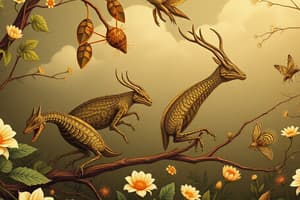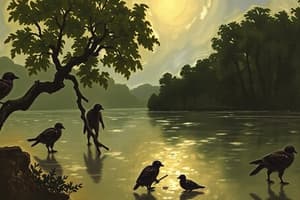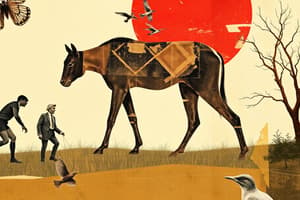Podcast
Questions and Answers
What is the most significant difference between Darwin's theory of evolution and the ideas put forth by Lamarck?
What is the most significant difference between Darwin's theory of evolution and the ideas put forth by Lamarck?
- Darwin's theory emphasizes the role of natural selection, while Lamarck believed in inheritance of acquired traits. (correct)
- Darwin believed in the gradual change of species over time, while Lamarck proposed that species are fixed.
- Darwin's theory is based on the concept of common descent, while Lamarck's theory argued for separate origins of species.
- Darwin's theory focuses on the variation within populations, while Lamarck emphasized the role of environmental pressures.
According to the provided timeline, which of the following events occurred closest in time to Darwin's publication of "On the Origin of Species"?
According to the provided timeline, which of the following events occurred closest in time to Darwin's publication of "On the Origin of Species"?
- Hutton's proposal of his principle of gradualism.
- Cuvier's extensive studies on vertebrate fossils.
- Malthus's publication of "Essay on the Principle of Population."
- Wallace sending his hypothesis of natural selection to Darwin. (correct)
Which of these concepts was NOT directly addressed in Darwin's "On the Origin of Species"?
Which of these concepts was NOT directly addressed in Darwin's "On the Origin of Species"?
- The concept of common descent for all living organisms.
- The idea that species change over time.
- The evidence for the immense age of the Earth.
- The mechanism of inheritance for traits. (correct)
The timeline highlights the influence of Hutton's principle of gradualism on Darwin's thought. What is the central idea of gradualism?
The timeline highlights the influence of Hutton's principle of gradualism on Darwin's thought. What is the central idea of gradualism?
What is one key difference between the applications of evolutionary theory in the US and Nazi Germany?
What is one key difference between the applications of evolutionary theory in the US and Nazi Germany?
Which of the following is NOT an example of direct observation of evolutionary change?
Which of the following is NOT an example of direct observation of evolutionary change?
What is the key difference between homology and analogy?
What is the key difference between homology and analogy?
Which of the following is an example of a vestigial structure?
Which of the following is an example of a vestigial structure?
What is the central assumption of phylogenetic systematics?
What is the central assumption of phylogenetic systematics?
Which of the following is NOT a characteristic of a species that has undergone specialization in a stable environment?
Which of the following is NOT a characteristic of a species that has undergone specialization in a stable environment?
In the context of evolutionary change, what does "convergent evolution" refer to?
In the context of evolutionary change, what does "convergent evolution" refer to?
What is the significance of Darwin's Finches in the context of evolution?
What is the significance of Darwin's Finches in the context of evolution?
What does the term "homoplasy" refer to in the context of evolutionary biology?
What does the term "homoplasy" refer to in the context of evolutionary biology?
What does the theory of organic evolution suggest about the organisms on Earth?
What does the theory of organic evolution suggest about the organisms on Earth?
Which classification system was introduced by Carolus Linnaeus?
Which classification system was introduced by Carolus Linnaeus?
What concept did Georges-Louis Leclerc, Comte de Buffon introduce during his studies?
What concept did Georges-Louis Leclerc, Comte de Buffon introduce during his studies?
What is the primary focus of Carolus Linnaeus's work in taxonomy?
What is the primary focus of Carolus Linnaeus's work in taxonomy?
In what year was 'On the Origin of Species' published, establishing Darwin's theory of descent with modification?
In what year was 'On the Origin of Species' published, establishing Darwin's theory of descent with modification?
What concept did Georges Cuvier propose regarding geological events and extinctions?
What concept did Georges Cuvier propose regarding geological events and extinctions?
Which principle did Jean Baptiste Lamarck incorrectly attribute to the process of evolution?
Which principle did Jean Baptiste Lamarck incorrectly attribute to the process of evolution?
What explanation did Thomas Malthus provide for the decline in living conditions?
What explanation did Thomas Malthus provide for the decline in living conditions?
How did Charles Lyell advance the ideas of James Hutton?
How did Charles Lyell advance the ideas of James Hutton?
What is a major theme in the works of Charles Darwin?
What is a major theme in the works of Charles Darwin?
Which of the following statements best describes the concept of homology?
Which of the following statements best describes the concept of homology?
According to Baer's Law, what develops earlier in the ontogeny of a group of animals?
According to Baer's Law, what develops earlier in the ontogeny of a group of animals?
Haekel's Biogenetic Law suggests that ontogeny can provide insights into which aspect of a group?
Haekel's Biogenetic Law suggests that ontogeny can provide insights into which aspect of a group?
What is the principle of recapitulation in the context of ontogeny and phylogeny?
What is the principle of recapitulation in the context of ontogeny and phylogeny?
What are pharyngeal pouches and slits?
What are pharyngeal pouches and slits?
What is a cervical fistula?
What is a cervical fistula?
What is the significance of the fossil record for supporting the theory of evolution?
What is the significance of the fossil record for supporting the theory of evolution?
What is biogeography, and how does it contribute to the evidence for evolution?
What is biogeography, and how does it contribute to the evidence for evolution?
Which of these is NOT a key observation that influenced Darwin's theory of evolution?
Which of these is NOT a key observation that influenced Darwin's theory of evolution?
What is the main difference between Darwin's theory of evolution and Lamarck's hypothesis?
What is the main difference between Darwin's theory of evolution and Lamarck's hypothesis?
Which of the following is NOT a component of Darwin's theory of evolution by natural selection?
Which of the following is NOT a component of Darwin's theory of evolution by natural selection?
What was the significance of Alfred Russel Wallace's contribution to Darwin's theory of evolution?
What was the significance of Alfred Russel Wallace's contribution to Darwin's theory of evolution?
What did Darwin observe during his voyage on the HMS Beagle that influenced his theory of evolution?
What did Darwin observe during his voyage on the HMS Beagle that influenced his theory of evolution?
What is the role of "natural selection" in Darwin's theory of evolution?
What is the role of "natural selection" in Darwin's theory of evolution?
The article discusses how Darwin's theory of evolution initially faced strong public resistance. What is the primary reason for this resistance?
The article discusses how Darwin's theory of evolution initially faced strong public resistance. What is the primary reason for this resistance?
What is the main idea presented in the quote "Truth is born into this world only with pangs and tribulations, and every fresh truth is received unwillingly"?
What is the main idea presented in the quote "Truth is born into this world only with pangs and tribulations, and every fresh truth is received unwillingly"?
Flashcards
Catastrophism
Catastrophism
The idea that past geological changes occurred suddenly and dramatically, often due to catastrophic events like floods or volcanic eruptions.
Gradualism
Gradualism
A theory that explains the gradual changes in Earth's geological features over long periods, driven by slow and continuous processes still happening today, such as erosion.
Uniformitarianism
Uniformitarianism
The concept that geological processes operate at the same rate in the past as they do in the present.
Inheritance of acquired characteristics
Inheritance of acquired characteristics
Signup and view all the flashcards
Malthusian principle
Malthusian principle
Signup and view all the flashcards
Theory of Organic Evolution
Theory of Organic Evolution
Signup and view all the flashcards
Scala Naturae
Scala Naturae
Signup and view all the flashcards
Museum Wormianum
Museum Wormianum
Signup and view all the flashcards
Carl Linnaeus
Carl Linnaeus
Signup and view all the flashcards
Georges-Louis Leclerc, Comte de Buffon
Georges-Louis Leclerc, Comte de Buffon
Signup and view all the flashcards
Earth's Age
Earth's Age
Signup and view all the flashcards
Species Change Over Time
Species Change Over Time
Signup and view all the flashcards
Unity of Life
Unity of Life
Signup and view all the flashcards
Natural Selection
Natural Selection
Signup and view all the flashcards
Adaptation
Adaptation
Signup and view all the flashcards
Evolution
Evolution
Signup and view all the flashcards
Voyage of the Beagle
Voyage of the Beagle
Signup and view all the flashcards
Alfred Russel Wallace
Alfred Russel Wallace
Signup and view all the flashcards
On the Origin of Species
On the Origin of Species
Signup and view all the flashcards
Variability in Organisms
Variability in Organisms
Signup and view all the flashcards
Overproduction of Offspring
Overproduction of Offspring
Signup and view all the flashcards
Artificial selection
Artificial selection
Signup and view all the flashcards
Direct observation of evolutionary change
Direct observation of evolutionary change
Signup and view all the flashcards
Phylogeny
Phylogeny
Signup and view all the flashcards
Homology
Homology
Signup and view all the flashcards
Convergent evolution
Convergent evolution
Signup and view all the flashcards
Embryology
Embryology
Signup and view all the flashcards
Vestigial structures
Vestigial structures
Signup and view all the flashcards
Fossil record
Fossil record
Signup and view all the flashcards
Homologous Features
Homologous Features
Signup and view all the flashcards
Ontogeny
Ontogeny
Signup and view all the flashcards
Baer's Law
Baer's Law
Signup and view all the flashcards
Haeckel's Biogenetic Law
Haeckel's Biogenetic Law
Signup and view all the flashcards
Principle of Recapitulation
Principle of Recapitulation
Signup and view all the flashcards
Cervical Fistulae
Cervical Fistulae
Signup and view all the flashcards
Biogeography
Biogeography
Signup and view all the flashcards
Study Notes
Evolution
- Evolution is the process of descent with modification whereby organisms change over time, producing new species.
Evidence of Evolution
- Artificial Selection: Humans have used selective breeding to change the characteristics of organisms over time.
- Direct Observation: Evolutionary change can be seen in organisms over a short period of time. Examples: Darwin's Finches and Peppered Moths.
- Phylogeny: The evolutionary relationships among organisms. Organisms are grouped by ancestry. Phylogenies show the evolutionary history and connections between organisms.
- Homology and Convergent Evolution: Homologous structures share a common ancestor and similar evolutionary pathways. Convergent evolution is where similar structures evolve independently in different lineages due to adapting to similar environments.
- Embryology and Ontogeny: Comparing the early stages of development (embryos) across different species reveals similarities, suggesting common ancestry. Ontogeny (development) can show relationships between phylogeny (evolution).
- Vestigial Structures: These are structures that have lost their original function over time, but remain in their descendants because of ancestry.
- Fossil Records: Fossil evidence shows the existence of extinct organisms and their progression over time. Fossils provide a record of life on Earth's history and reveal the sequence of evolution.
- Biogeography: The study of geographic distribution of organisms. Similar organisms are present in different geographic areas can suggest common ancestry. The distribution of organisms is affected by continental drift and other geological processes.
Additional Concepts
- Atavism: An evolutionary throwback, a trait reappearing that was previously lost in the lineage but existed in ancestors.
- Phylogenetic Systematics: Assumptions including evolution, single phylogeny for all life, and character inheritance.
Studying That Suits You
Use AI to generate personalized quizzes and flashcards to suit your learning preferences.
Related Documents
Description
Explore the fundamentals of evolution, including the process of descent with modification and the evidence that supports this theory. This quiz covers concepts like artificial selection, direct observation, phylogeny, homology, and embryology. Test your knowledge of how organisms have changed over time and the connections among species.




